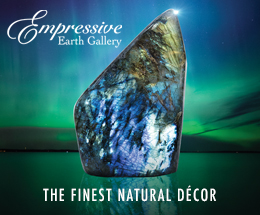Previously, I discussed American minerals and some of my recent travels here in the States to uncover remarkable specimens. Not only is the United States filled with extraordinary minerals, but there are also fascinating remnants of ancient animals, including dinosaurs, Ice Age mammals and other iconic creatures. The specific fossils that I’ll be discussing come from different parts of the country and date as far back as the Jurassic Period to as recent as the Pleistocene Epoch.

Our company, Empressive Earth Gallery, has sourced American fossils from as far south as the swamps of Florida to as far north as the forests of Alaska. Hidden in the snow of Alaska are remnants of the gargantuan woolly mammoth, with tusks that occasionally exceed 10 feet in length and exhibit a plethora of magnificent colors, such as rare blue and green hues caused by the mineral vivianite. From Florida we’ve acquired a variety of giant crocodilian skulls and a nearly complete skeleton of an extinct bird species. Since it was found as fragments, the bird skeleton was especially challenging to piece back together due to the fragility of its many small bones. Nonetheless, the final display with its outstretched wings was a majestic sight to behold.
One of my most exciting American fossil encounters was last year with a juvenile Tyrannosaurus rex skull. Upon being contacted by a veteran fossil hunter about a baby T. rex skull that he had recently excavated in Wyoming, I immediately negotiated a deal to acquire it prior to any public information being broadcasted. Due to its rarity and value, we sold the skull within 24 hours. Accordingly, it is important to be as expeditious and private as possible when searching and negotiating for fossils since many collectors and institutions will pounce on an opportunity to acquire a unique specimen.

Occasionally, the sale of a fossil can occur before it is fully unearthed. This occurred last year with a 67-million-year-old Triceratops skull that was discovered in Montana by a team of amateur paleontologists. I traveled to the dig site while the skull was still in the ground and utilized my expertise to determine the approximate size, completeness and quality of the specimen. It was promptly sold to a private collector, and thousands of hours were then spent to excavate, restore and mount the 6-foot skull of this renowned three-horned dinosaur.
Sometimes discovering a fossil can happen by absolute luck, which was the case with a rancher who quite literally stumbled upon an Allosaurus skull on his land in Colorado. He had noticed part of the jaw exposed on a slope, and we were able to confirm that it was the skull of a 150-million-year-old carnivorous dinosaur. This specimen exhibited a phenomenal dark gray hue and dozens of sharp teeth that were highly effective for slashing and tearing. It was a truly exceptional skull, and one of my favorite pieces.

Certain fossilized teeth are of significant value, as seen with the extinct megalodon shark teeth found in rivers and off the coast of the Carolinas. Megalodon could grow over 50 feet in length with teeth reaching over 6 inches diagonally and displaying a variety of colors and patterns depending on the mineral content of the seabed in which they were buried. The divers I work with spend countless days scouring the dim ocean floor hoping to uncover the triangular serrated enamel that is perhaps the most iconic tooth of the fossil trade.

Other fossils of aquatic animals include prehistoric fish, turtles and crocodiles that are often intensely compressed within layers of rock. These are termed “compression fossils,” which require a particularly delicate approach when excavating and cleaning due to the thinness of their structures. A slip of the wrist during preparation can damage the fossil, and it therefore requires expert technique and significant patience to ensure that these pieces are preserved as meticulously as possible. One of the most fascinating compression fossils that I recently acquired is a giant stingray
from an ancient lakebed in Wyoming. This specimen is over 95% complete with a magnificent radiating shape consisting of hundreds of cartilaginous extensions as well as venomous spines along the end of its tail.

My passion for fossils, as well as my numerous encounters with fake, composited, misidentified or deceptively restored specimens, led me to form the Paleontological Institute of America (PIA) to serve as a scientific organization dedicated to the authentication and appraisal of fossils. PIA consists of paleontologists and experts with extensive experience researching and preparing fossil specimens and has established itself as a reliable authority in the field of paleontology. Our services have been provided to museums, private collectors, U.S. Customs and the U.S. Department
of Homeland Security. Whether it be fossils from the United States or abroad, having confidence in the authenticity of a specimen is critical prior to committing to the investment. *
Micah Gilbert, owner of Empressive Earth Gallery, is a geologist, paleontologist and gemologist with a trained eye for meticulously sourcing high-quality specimens that make for exquisite décor.














